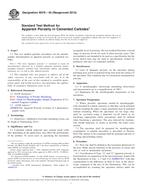Potřebujeme váš souhlas k využití jednotlivých dat, aby se vám mimo jiné mohly ukazovat informace týkající se vašich zájmů. Souhlas udělíte kliknutím na tlačítko „OK“.
ASTM D7743-12
Standard Test Method for Measuring the Minimum Fluidization Velocities of Free Flowing Powders (Withdrawn 2021)
Automaticky přeložený název:
Standardní zkušební metoda pro měření Minimální Fluidizace rychlostí sypký Prášky
NORMA vydána dne 1.6.2012
Informace o normě:
Označení normy: ASTM D7743-12
Poznámka: NEPLATNÁ
Datum vydání normy: 1.6.2012
Kód zboží: NS-39049
Počet stran: 7
Přibližná hmotnost: 21 g (0.05 liber)
Země: Americká technická norma
Kategorie: Technické normy ASTM
Kategorie - podobné normy:
Anotace textu normy ASTM D7743-12 :
Keywords:
complete fluidization, fluidization, Geldart Group A, Geldart Group B, minimum bubbling velocity, minimum fluidization velocity, ICS Number Code 77.160 (Powder metallurgy)
Doplňující informace
| Significance and Use | ||||||||||
|
5.1 The data from this test can be used to determine the superficial gas velocity required to suspend a bed of powder in the fluidized state and the resulting pressure drop. 1.1 This test method describes the
apparatus and procedure needed for determining the minimum
fluidization velocity of Geldart Group A powders and the minimum
fluidization or complete fluidization velocity of Geldart Group B
powders.
1.1.1 This test method is for powders that are readily or easily fluidizable and fall into the category of Group A and B of the “Geldart” classification. The fluidization of Geldart Group C powders will be addressed in another standard. This test method could apply to Geldart Group D particles but the focus of this document is towards Group and A and B materials. 1.1.2 Geldart classification of powders is often defined by comparing the Sauter mean particle size with the difference between the particle density and the density of the fluidizing gas, as illustrated in Fig. 1 (1).2 FIG. 1 Geldart Classification of
Particles
1.1.2.1 Group A powders are easily fluidized but there is a difference between the gas velocity where the bed is initially fluidized and the velocity where bubbles are first observed. For Group A powders, bed expansion can be considerable before any bubbles are observed. Group B powders are also easily fluidized; but there is no difference between the velocity where the bed is fluidized and the velocity at the onset of bubbling. The minimum gas velocity, where all of the particles are fully supported by the gas for Group B powders, is often referred to as the “complete fluidization velocity” instead of minimum fluidization velocity. Group C powders are cohesive and can be difficult to fluidize. 1.1.2.2 Group A powders can be distinguished from Group B powders by the response to deaeration. Group A powders deaerate relatively slowly whereas Group B powders deaerate almost instantaneously in fluidized beds. 1.1.2.3 Group A Powders that lie near or on the Group A/C boundary may be tested by this method. However, if the powders do not fluidize freely, test results should be considered invalid. 1.1.2.4 Temperature, moisture (water) content, particle size distribution, particle shape and sometimes other variables influence the Geldart classification of a powder. Deaeration testing specified in 1.1.2.2 is a more definitive test than simply using particle size and density differences as described in 1.2 This test method should be performed in a laboratory under controlled conditions of temperature and humidity. 1.3 All observed and calculated values shall conform to the guidelines for significant digits and rounding established in Practice D6026. 1.3.1 The procedures used to specify how data are collected/recorded or calculated, in this standard are regarded as the industry standard. In addition they are representative of the significant digits that generally should be retained. The procedures used do not consider material variations, the purpose for obtaining the data, special purpose studies, or any considerations for the user’s objectives; and it is common practice to increase or reduce significant digits of reported data to be commensurate with these considerations. It is beyond the scope of this standard to consider significant digits used in analysis methods for engineering design. 1.4 The values stated in SI units are to be regarded as standard. No other units of measurement are included in this standard. 1.5 This standard does not purport to address all of the safety concerns, if any, associated with its use. It is the responsibility of the user of this standard to establish appropriate safety and health practices and determine the applicability of regulatory limitations prior to use. |
||||||||||
| 2. Referenced Documents | ||||||||||
|
Podobné normy:
Historická
1.12.2010
Historická
1.11.2013
Historická
1.9.2010
Historická
1.4.2013
Historická
1.6.2014
Historická
1.10.2012
Doporučujeme:
Aktualizace technických norem
Chcete mít jistotu, že používáte pouze platné technické normy?
Nabízíme Vám řešení, které Vám zajistí měsíční přehled o aktuálnosti norem, které používáte.
Chcete vědět více informací? Podívejte se na tuto stránku.



 ASTM B215-10
ASTM B215-10 ASTM B243-13
ASTM B243-13 ASTM B276-05(2010)..
ASTM B276-05(2010).. ASTM B311-13
ASTM B311-13 ASTM B312-14
ASTM B312-14 ASTM B329-06(2012)..
ASTM B329-06(2012)..
 Cookies
Cookies
